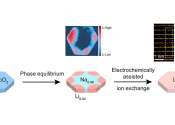In chemistry, the empirical formula of a chemical compound is a simple expression of the relative numbers of each type of atom in it, or the simplest whole number ratio of atoms of each element present in a compound. An empirical formula makes no reference to isomerism, structure, or absolute number of atoms. The empirical formula is used as standard for most ionic compounds, such as CaCl2, and for macromolecules, such as SiO2. The term empirical refers to the process of elemental analysis, a technique of analytical chemistry used to determine the relative amounts of each element in a chemical compound.
In contrast, the molecular formula identifies a numbers of each type of atom in a molecule, and the structural formula also shows the structure of the molecule.
For example, the chemical compound n-hexane has the structural formula CH3CH2CH2CH2CH2CH3, which shows that it has 6 carbon atoms arranged in a straight chain, and 14 hydrogen atoms. Hexane's molecular formula is C6H14, and its empirical formula is C3H7, showing a C:H ratio of 3:7. Different compounds can have the same empirical formula. For example, glucose, formaldehyde and acetic acid have the same empirical formula, CH2O. This is the actual chemical formula for formaldehyde, but acetic acid has double the number of atoms and glucose has six times the number of atoms.









